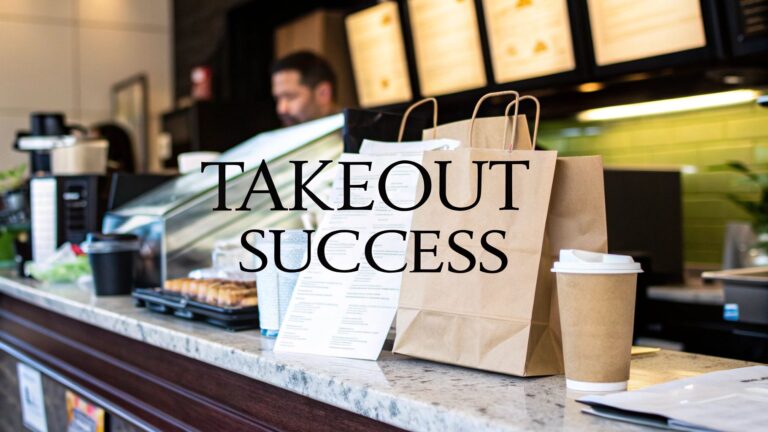Why Your Bag Choice Makes or Breaks Customer Loyalty
Takeout has exploded, and customer expectations have gone way up. It’s not just about the food anymore; it’s the whole experience. And you know what? The experience starts with the bag. I’ve chatted with tons of restaurant owners, and the ones who are killing it get this: restaurant takeout bags are a major touchpoint. It’s the first thing your customer touches, and it shapes their impression before they even crack open the container.
That first impression is everything. A soggy bag, spilled food, or a flimsy container instantly cheapens the meal, even if the food looks amazing inside. Think about it – haven’t you ever gotten an order in a sad bag and felt a little let down? Even if the food looked fine? That’s the power of packaging. It sets the tone for the whole meal.
Let’s say you order sushi from a fancy place. Getting it in a basic brown bag just feels wrong, right? It doesn’t match the price or the delicate food. But imagine that same order in a sleek, branded bag with a good closure. Totally different. Suddenly, it feels high-end, reinforcing the restaurant’s quality.
This kind of attention to detail is huge in today’s competitive market. Takeout is booming! The global market was valued at about $2681.86 billion in 2024, and it’s projected to hit $2936.83 billion in 2025. That’s a 9.5% CAGR! This growth means restaurants have to stand out. And guess what? Your takeout bag is a perfect way to do it. Smart owners are using this to build loyalty and make customers happy. They’re realizing the right bag isn’t just a container; it’s an investment. It’s an investment in happy customers and, honestly, their bottom line.
Finding the Perfect Material for Your Restaurant Style
The infographic gives a snapshot of what restaurants are using right now: 60% paper, 25% plastic, and 15% compostable. Paper’s definitely having a moment, reflecting the bigger push for sustainability. But choosing the right bag for your restaurant involves a few more layers than just following the trend.
Picking takeout bags isn’t just about looks – it impacts your brand, your budget, and how your food travels. Kraft paper bags have that down-to-earth vibe, and I’ve seen upscale spots use them effectively. Think artisanal sandwiches or pastries nestled in kraft paper with a clean, minimalist logo. A bakery near me does this, and it elevates the whole experience. Speaking of elevating the experience, your takeout packaging plays a crucial role in customer loyalty.
Beyond the Basics: Exploring Material Options
Kraft paper isn’t the answer for every dish, though. If your menu features saucy dishes or anything with higher moisture content, you’ll need something sturdier. Coated paper or plastic-lined paper can prevent leaks and keep the bag from falling apart. A friend learned this the hard way – switched to uncoated paper for pasta dishes, and it was a mess. Soggy bags equal unhappy customers.
Then there’s plastic. It’s durable and moisture-resistant, so it’s still around. But with everyone focused on the environment, it’s losing popularity. Compostable options are gaining ground, but they often come with a higher price tag. This demand for eco-friendly options, like paper bags, is definitely growing, driven by stricter regulations on plastic and a general shift toward sustainable packaging. The food and beverage industry currently holds about 46% of the paper bag market share.
To help you visualize the pros and cons of different materials, I’ve put together a quick comparison table:
Restaurant Takeout Bag Material Comparison
| Material Type | Cost Range | Durability | Eco-Friendly Rating | Best Food Types | Customer Perception |
|---|---|---|---|---|---|
| Kraft Paper | Low | Moderate | High | Dry foods, baked goods | Natural, artisanal |
| Coated Paper | Medium | High | Moderate | Foods with some moisture | Practical, clean |
| Plastic-Lined Paper | Medium-High | High | Low | Saucy foods, hot items | Reliable, but less eco-conscious |
| Plastic | Low | High | Low | All food types | Cost-effective, but environmentally unfriendly |
| Compostable | High | Moderate | High | All food types | Environmentally responsible, premium |
The table highlights how each material performs, making it easier to match your bag choice to your specific needs. Remember, the “perfect” material depends on what you’re serving, who you’re serving it to, and your budget.
Keeping Food Perfect With Smart Insulation Choices
We’ve already covered bag materials, but now let’s talk temperature. Nobody wants lukewarm fries or a cold pizza arriving at their door. Trust me, that’s a recipe for negative reviews. Insulated restaurant takeout bags are key to keeping your food at the right temperature. I’ve personally seen restaurants turn their customer feedback around simply by switching to better insulated bags.
And it’s not about shelling out for the priciest option. I’ve seen expensive, “high-tech” bags totally fail, while simple, budget-friendly ones worked like a charm. The trick is finding the right insulation for your specific menu. For example, I know pizza places that live and die by their thick, padded bags designed to lock in heat. For other hot foods, foil-lined bags can be surprisingly effective.
Matching Insulation to Your Menu
Different food means different needs. A salad bar might be fine with a thin thermal liner to keep things crisp, but a restaurant specializing in hot soups needs serious insulation. Think about what you’re serving and what kind of temperature it needs to maintain. These details truly impact the customer experience.
By the way, the insulated food delivery bag market is booming. It was valued at about $16,519 million in 2025 and is projected to hit $31,840 million by 2035, growing at a 6.8% CAGR. This just goes to show how important temperature control is becoming in the takeout world.
Making the Investment Pay Off
Good insulation doesn’t have to cost a fortune. Think about your return on investment (ROI). How much are you losing on remakes or refunds because of cold food complaints? Compare that to the cost of new, insulated bags. You’ll often find the upgrade pays for itself pretty quickly through increased customer satisfaction and fewer issues. Even small improvements can have a huge positive impact on your reputation and profits.
Getting Size and Capacity Right Every Time
Nobody wants squished takeout. I’ve seen it happen too many times – drivers struggling with overflowing bags, customers disappointed with crushed food. It’s a lose-lose. In my experience working with restaurants, from tiny cafes to massive chains, the biggest mistake they make is using generic, one-size-fits-all bags. Your takeout bags should fit your food, not some imaginary average order.
Offering a range of bag sizes is crucial. A small pastry doesn’t need a massive bag, and trying to cram a family feast into something tiny is a recipe for disaster. Having multiple sizes keeps your customers happy and streamlines your operations. It’s all about efficiency and presentation – no more stuffing or wasted space.
So, how do you find the right fit? Start by analyzing your typical orders. If most orders are just one or two items, a smaller bag (around 10x8x12 inches) should do the trick. For larger orders, consider medium (12x10x15 inches) or large (16x12x18 inches) options. It’s about tailoring the bag to your specific menu and customer base. I once helped a local sandwich shop optimize its bag sizes, and it made a huge difference, both in terms of material costs and customer satisfaction. No more complaints about squished sandwiches!
The Psychology of Bag Size
Here’s an interesting point: the size of your bag can actually influence how customers perceive their order. A huge bag for a small order can make it feel smaller, almost lost. The right-sized bag, however, makes the order feel complete and valued. It enhances the overall experience, like receiving a perfectly wrapped gift.
While oversized bags might seem generous, they can actually hurt your bottom line. More material means higher costs and increased storage needs. I’ve seen restaurants waste so much money on oversized bags filled with mostly air. It’s about finding the balance between customer perception and your budget.
To give you a clearer idea, let’s look at some recommendations:
Optimal Bag Sizes by Restaurant Type
| Restaurant Type | Small Bag Size | Medium Bag Size | Large Bag Size | Typical Use Cases | Cost Impact |
|---|---|---|---|---|---|
| Cafe/Bakery | 8x6x10 inches | 10x8x12 inches | 12x10x14 inches | Pastries, single beverages, small sandwiches | Lowest |
| Sandwich Shop/Deli | 10x8x12 inches | 12x10x15 inches | 14x12x16 inches | Sandwiches, salads, wraps, multiple items | Low to Medium |
| Pizza Place | 12x12x4 inches | 16x16x4 inches | Single pizzas, side orders | Medium | |
| Burger Joint | 10x8x12 inches | 12x10x15 inches | 16x12x18 inches | Burgers, fries, drinks, combo meals | Medium to High |
| Family Restaurant/Multi-Cuisine | 12x10x15 inches | 16x12x18 inches | Variety of dishes, family meals, large orders | Highest |
This table offers a starting point. You might find that slightly different sizes work better for your specific menu. The key takeaway is to analyze your orders and choose sizes that fit your needs, maximizing customer satisfaction and minimizing waste.
Turning Your Bags Into Marketing Assets That Work
Think of your restaurant’s takeout bags as mobile ads, not just containers. I’ve seen restaurants cleverly turn their bags into brand boosters without spending a fortune. Every customer strolling around with your bag is free advertising, and with the rise of delivery, that’s a huge opportunity. The DoorDash 2025 Delivery Trends Report found that 47% of Americans order in at least once a week. That’s a lot of potential impressions for your branded bags!
Simple Designs, Big Impact
One thing I’ve noticed is that simple bag branding often makes the biggest splash. A clean logo, your restaurant’s name, and maybe a catchy tagline can be much more effective than a busy design. There’s a burger place near me that uses plain brown Kraft bags with their logo stamped in red – it’s so striking and perfectly reflects their simple, quality-over-everything approach. If you’re looking for more ideas, check out this article on branded food containers: Boost Your Brand With Branded Food Containers.
Adding a QR code that links to your online ordering or social media is another smart move. It makes it easy for customers to reorder or engage with you online, directly connecting their takeout experience back to your business. Speaking of social media, the DoorDash report also mentioned that over half of Americans (56%) have ordered something they saw trending online. A QR code makes that connection seamless.
Balancing Brand and Budget
Branded bags are a smart investment, but you have to be strategic. Start with a small batch, maybe for a specific promotion, and see how it goes. Monitor your online orders and social media engagement – any noticeable increase? If so, you know it’s working! If not, tweak your design or strategy.
Never underestimate the power of a well-designed bag. It’s a tangible piece of your brand, a pleasant reminder of a good meal, and a subtle encouragement for their next order.
Smart Implementation Without Breaking Your Budget
Upgrading your restaurant’s takeout bags doesn’t have to mean maxing out your credit cards. I’ve chatted with a bunch of restaurant owners who’ve successfully transitioned to better bags without breaking the bank. Their secret? A phased approach.
Don’t feel like you need to swap everything overnight. Try a small test run, maybe with your top-selling dishes or during your busiest times. This lets you see how the new bags hold up in the real world and get feedback from customers before placing a huge order. I know one local cafe that started by using upgraded bags just for their weekend brunch rush. The customers loved it, and that convinced them to make a complete switch.
Negotiating Smartly and Managing Inventory
Haggling with vendors is essential! Don’t hesitate to ask for samples or discounts for smaller orders. Most suppliers are happy to work with you, especially if you’re a regular customer. It’s just like buying anything in bulk—the larger the order, the better the price. This totally applies to takeout bags, too.
Inventory management is another critical piece of the puzzle. Switching to new bags doesn’t mean you have to trash your current stash. Use up your existing inventory strategically, maybe for items where presentation isn’t as crucial, or by letting customers choose. This minimizes waste and makes the financial side of switching over much smoother.
Measuring Impact and Maximizing ROI
Once you’ve rolled out the new bags, keep an eye on how things change. Check your online reviews—are there fewer gripes about soggy bags or spills? Are your online orders ticking upwards? Something I’ve seen work wonders is adding a small, nicely packaged treat to the bag. Think along the lines of a little gift, like you’d see in collections. These little touches can really boost the perceived value and create a great lasting impression.
Pay attention to your operational efficiency, too. Are your delivery drivers finding the bags easier to handle? Are orders getting fulfilled faster? These are real signs of whether your bag upgrade is paying off. Remember, the goal isn’t just about aesthetics—it’s about improving your profits and keeping your customers happy.
Some upgrades have a faster return than others. For example, insulated bags for hot food can often quickly pay for themselves by cutting down on remakes due to temperature issues. By tracking these practical things, you’ll not only justify the bag expense but also pinpoint areas where you can tweak your takeout operations for even better results.
Your Action Plan for Takeout Bag Success
So, we’ve covered a lot of ground, from the nitty-gritty of materials to the buzz of marketing. Now, let’s get down to brass tacks: how to make all this work for your business. Think of this as your personalized roadmap to takeout bag success, pulling together everything we’ve discussed into a practical, actionable plan.
Choosing the Right Bags
First things first: take a good look at your menu. What are you serving up? Mostly dry dishes? Saucy delights? Or a mix of both? This is your starting point for choosing the right material. Next, consider your average order size. A single sandwich doesn’t need a massive bag, while a family feast does. Remember that sandwich shop I mentioned? Simply tweaking their bag size made a real difference to their bottom line.
Implementation Timeline
Don’t feel like you need to overhaul your entire system overnight. Start small. Try a limited rollout of your new restaurant’s takeout bags with a specific menu item or during a busy period like lunch or dinner rush. This is a great way to get real-world feedback from your staff and customers before you commit to a huge order. That local cafe I talked about? They tested their new bags during their weekend brunch rush and then gradually rolled them out across the rest of their menu. Smart, right?
Measuring Success
Keep an eye on the things that matter: customer reviews, online orders, and even feedback from your delivery drivers. Are you seeing fewer complaints about spills? Are online orders ticking upwards? These are all positive indicators that you’re on the right track. Because at the end of the day, the right takeout bags aren’t just about looking good – they’re about boosting customer satisfaction and your bottom line.
Ready to take the plunge and upgrade your takeout packaging? MrTakeOutBags.com has a huge selection of bags, boxes, and everything in between to suit every need.







Comments are closed.